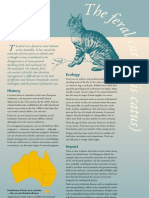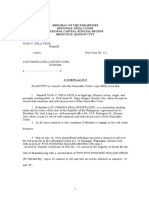0 ratings0% found this document useful (0 votes)
5 viewsSpawnspot 0208
Spawnspot 0208
Uploaded by
Rover DiompocFrogs and toads naturally breed in large numbers in garden ponds in the spring, though many people see this as an unwelcome intrusion. While populations may seem high, natural factors keep numbers in check. Conservationists are asking the public to help survey frog and toad numbers by counting spawn, as amphibian populations are declining due to pollution, habitat loss, and increased road traffic. More information can be found by contacting the Holly Hayes Environment and Resources Centre.
Copyright:
© All Rights Reserved
Available Formats
Download as DOC, PDF, TXT or read online from Scribd
Spawnspot 0208
Spawnspot 0208
Uploaded by
Rover Diompoc0 ratings0% found this document useful (0 votes)
5 views1 pageFrogs and toads naturally breed in large numbers in garden ponds in the spring, though many people see this as an unwelcome intrusion. While populations may seem high, natural factors keep numbers in check. Conservationists are asking the public to help survey frog and toad numbers by counting spawn, as amphibian populations are declining due to pollution, habitat loss, and increased road traffic. More information can be found by contacting the Holly Hayes Environment and Resources Centre.
Original Description:
spawnspot
Original Title
spawnspot_0208
Copyright
© © All Rights Reserved
Available Formats
DOC, PDF, TXT or read online from Scribd
Share this document
Did you find this document useful?
Is this content inappropriate?
Frogs and toads naturally breed in large numbers in garden ponds in the spring, though many people see this as an unwelcome intrusion. While populations may seem high, natural factors keep numbers in check. Conservationists are asking the public to help survey frog and toad numbers by counting spawn, as amphibian populations are declining due to pollution, habitat loss, and increased road traffic. More information can be found by contacting the Holly Hayes Environment and Resources Centre.
Copyright:
© All Rights Reserved
Available Formats
Download as DOC, PDF, TXT or read online from Scribd
Download as doc, pdf, or txt
0 ratings0% found this document useful (0 votes)
5 views1 pageSpawnspot 0208
Spawnspot 0208
Uploaded by
Rover DiompocFrogs and toads naturally breed in large numbers in garden ponds in the spring, though many people see this as an unwelcome intrusion. While populations may seem high, natural factors keep numbers in check. Conservationists are asking the public to help survey frog and toad numbers by counting spawn, as amphibian populations are declining due to pollution, habitat loss, and increased road traffic. More information can be found by contacting the Holly Hayes Environment and Resources Centre.
Copyright:
© All Rights Reserved
Available Formats
Download as DOC, PDF, TXT or read online from Scribd
Download as doc, pdf, or txt
You are on page 1of 1
Amorous Amphibians
If you have a garden pond, you may experience an annual amorous
amphibian take-over around spring. For some, this is a fascinating
phenomenon, or a hopeful sign of the forthcoming summer. For others, it
is an unwelcome intrusion of nature, a distasteful exhibition.
Many people are concerned that they have too many frogs or too much
frogspawn in their pond. Ponds can seem to be overcrowded with spawn,
tadpoles or adult frogs but as long as frogs or spawn have not been added
from elsewhere, this is a natural situation. Amphibian populations
naturally fluctuate and large numbers of frogs can simply be short-lived
peaks. Numbers of frogs, tadpoles and spawn, are kept under control by
natural factors. Frogs and tadpoles are food for many wild animals; they
suffer from disease and are killed by extremes of temperature. By laying
large numbers of eggs, frogs can ensure that some of their offspring will
survive these perils - only four of every 2000 eggs will live to become
breeding adults.
People may sometimes feel inundated with frogs, but amphibians are in
fact not faring very well in the UK. Pollution, damage to, or loss of
habitats, and disease are all having an effect. Recent research has shown
the common toad has undergone substantial declines in lowland areas,
especially central England, over the last 15 years, due in part to increased
road traffic killing migrating toads.
Conservationists at Leicestershire County Council are asking people to
help measure frog and toad numbers in Leicestershire and Rutland by
counting the clumps or strings of spawn. A free leaflet called Spawn Spot
describes how to take part in the survey, what to look for, and has advice
on common frog related problems and where to get more information.
To find out more information, contact the Holly Hayes Environment and
Resources Centre, 216 Birstall Road, Leicestershire LE4 4DG, telephone
(0116) 2671950, e-mail wildlife@leics.gov.uk or visit
www.leics.gov.uk/celebrating_wildlife.
You might also like
- Sad Eyes Empty LivesDocument4 pagesSad Eyes Empty LivesSheikh ErasNo ratings yet
- Pocket Guide to the Butterflies of Great Britain and IrelandFrom EverandPocket Guide to the Butterflies of Great Britain and IrelandRating: 5 out of 5 stars5/5 (2)
- Ghost Pipe Co RalphDocument17 pagesGhost Pipe Co RalphRichard RossNo ratings yet
- Cormorant Facts (From Environment Agency Website)Document4 pagesCormorant Facts (From Environment Agency Website)rob yorkeNo ratings yet
- Cane ToadDocument4 pagesCane ToadDbaltNo ratings yet
- BitternDocument9 pagesBitternMIhai MiuNo ratings yet
- River Murray Seals FAQDocument2 pagesRiver Murray Seals FAQWade WheelerNo ratings yet
- Gardening) Amphibians in Your GardenDocument12 pagesGardening) Amphibians in Your GardenVoinea ElenaNo ratings yet
- The Cane Toad: HistoryDocument2 pagesThe Cane Toad: HistoryringpieceNo ratings yet
- In Defence of MagpiesDocument2 pagesIn Defence of MagpiesBan Blood SportsNo ratings yet
- 随意一篇雅思阅读Document4 pages随意一篇雅思阅读赵小庚No ratings yet
- OtterDocument3 pagesOtterCông LêNo ratings yet
- The Complete Garden Bird Book: How to Identify and Attract Birds to Your GardenFrom EverandThe Complete Garden Bird Book: How to Identify and Attract Birds to Your GardenRating: 4 out of 5 stars4/5 (3)
- Guía para Proteger Ambientes HerpetológicosDocument10 pagesGuía para Proteger Ambientes HerpetológicosputarazoNo ratings yet
- Cameron 1927 The Helminth Parasites of Animals and Human DiseaseDocument10 pagesCameron 1927 The Helminth Parasites of Animals and Human DiseaseFatima malikNo ratings yet
- The Secret Life of an Arable Field: Plants, Animals and the EcosystemFrom EverandThe Secret Life of an Arable Field: Plants, Animals and the EcosystemNo ratings yet
- Newts Letter 42 Winter 2006Document13 pagesNewts Letter 42 Winter 2006Sussex Amphibian & Reptile GroupNo ratings yet
- ButterfliesDocument45 pagesButterfliesMaria Meli100% (2)
- Ielts MaterialDocument5 pagesIelts MaterialRetro FootballNo ratings yet
- Feral GoatDocument4 pagesFeral Goatapi-279811261No ratings yet
- Test Reading 11Document10 pagesTest Reading 11trantragiang1306No ratings yet
- T (Felis: EcologyDocument2 pagesT (Felis: EcologydavemikemcNo ratings yet
- Red Deer and Shearwaters: Solution For Manx Shearwater Infanticide On RhumDocument4 pagesRed Deer and Shearwaters: Solution For Manx Shearwater Infanticide On RhumMarten DondorpNo ratings yet
- Herons, Egrets and Bitterns: Their Biology and Conservation in AustraliaFrom EverandHerons, Egrets and Bitterns: Their Biology and Conservation in AustraliaRating: 5 out of 5 stars5/5 (1)
- Psfs FeralpigDocument2 pagesPsfs Feralpigapi-237614415No ratings yet
- European Red FoxDocument4 pagesEuropean Red Foxapi-2798112610% (1)
- Endangered Species ColoringDocument33 pagesEndangered Species ColoringvjramsieNo ratings yet
- Wood Wise - Protected Species - Summer 2012Document19 pagesWood Wise - Protected Species - Summer 2012woodlandtrustNo ratings yet
- IPA Fox PA13 PDFDocument4 pagesIPA Fox PA13 PDFColumbia GomezNo ratings yet
- Document MightDocument3 pagesDocument MightharshmichaNo ratings yet
- SurggggggggeDocument2 pagesSurggggggggeLOW KAR YIN MoeNo ratings yet
- Saving Animals E-Award PresentationDocument74 pagesSaving Animals E-Award PresentationNaphton ProjectsNo ratings yet
- Canadian Government Sets Hunt Quota of 400,000 Seals: International Fund For Animal Welfare IfawDocument6 pagesCanadian Government Sets Hunt Quota of 400,000 Seals: International Fund For Animal Welfare IfawjoeyOCNo ratings yet
- Woodland Management - Great Crested NewtsDocument2 pagesWoodland Management - Great Crested NewtswoodlandtrustNo ratings yet
- The Feral Cat (Felis Catus) : History EcologyDocument3 pagesThe Feral Cat (Felis Catus) : History Ecologyapi-279811261No ratings yet
- Feral Pig (Sus Scrofa) : Biology & EcologyDocument2 pagesFeral Pig (Sus Scrofa) : Biology & Ecologydeuce scriNo ratings yet
- Feeding Barn Owls 13Document3 pagesFeeding Barn Owls 13adi_nugraha_13No ratings yet
- Fur - An Environmental Nightmare: Water & Air PollutionDocument3 pagesFur - An Environmental Nightmare: Water & Air PollutionAik NoeraNo ratings yet
- The Basic Facts: Know Your HedgehogDocument4 pagesThe Basic Facts: Know Your HedgehogMarie MamatNo ratings yet
- Download Pocket Guide to the Butterflies of Great Britain and Ireland 2nd Edition Richard Lewington ebook All Chapters PDFDocument55 pagesDownload Pocket Guide to the Butterflies of Great Britain and Ireland 2nd Edition Richard Lewington ebook All Chapters PDFkamfaicodiNo ratings yet
- Invasive Crayfish Species Profiles - 0Document5 pagesInvasive Crayfish Species Profiles - 0karthikbs00No ratings yet
- Calling All BitternsDocument10 pagesCalling All BitternsMIhai MiuNo ratings yet
- Reading 2Document16 pagesReading 2yvo59623No ratings yet
- Instant ebooks textbook Pocket Guide to the Butterflies of Great Britain and Ireland 2nd Edition Richard Lewington download all chaptersDocument65 pagesInstant ebooks textbook Pocket Guide to the Butterflies of Great Britain and Ireland 2nd Edition Richard Lewington download all chapterschauxdulce2j100% (1)
- Camel FactsheetDocument5 pagesCamel Factsheetapi-293269391No ratings yet
- Living With Flying FoxesDocument2 pagesLiving With Flying FoxesfanymaewestNo ratings yet
- Wildlife Newsletter 10Document1 pageWildlife Newsletter 10FVASNo ratings yet
- Birds and Your GardenDocument20 pagesBirds and Your GardenjovmicicNo ratings yet
- British WildlifeDocument9 pagesBritish Wildlifeapi-427106949No ratings yet
- Pest Animal Fact Sheet: ImpactsDocument2 pagesPest Animal Fact Sheet: ImpactsBudi AfriyansyahNo ratings yet
- Declining BiodiversityDocument3 pagesDeclining BiodiversityJuan Jose Betancur UribeNo ratings yet
- Feral HorseDocument4 pagesFeral Horseapi-279811261No ratings yet
- Specific Performance ComplaintDocument4 pagesSpecific Performance ComplaintRover Diompoc67% (3)
- Vlookup Start ExampleDocument3 pagesVlookup Start Examplegian914No ratings yet
- Call MonitoringDocument56 pagesCall MonitoringRover Diompoc0% (1)
- Ong HUan Tin vs. RepublicDocument3 pagesOng HUan Tin vs. RepublicRover DiompocNo ratings yet
- People Vs LagahitDocument2 pagesPeople Vs LagahitRover DiompocNo ratings yet
- Hearsay Patula v. PeopleDocument1 pageHearsay Patula v. PeopleJeremiah John Soriano NicolasNo ratings yet
- Lee vs. CADocument14 pagesLee vs. CARover DiompocNo ratings yet
- Gerbert R. Corpuz v. Daisylyn Tirol Sto. TomasDocument7 pagesGerbert R. Corpuz v. Daisylyn Tirol Sto. TomasmisterdodiNo ratings yet
- Duty To Society, The Legal Profession, The Courts and Their Clients in Accordance With The ValuesDocument1 pageDuty To Society, The Legal Profession, The Courts and Their Clients in Accordance With The ValuesRover DiompocNo ratings yet
- Braza Vs City Civil RegistrarDocument3 pagesBraza Vs City Civil RegistrarRose AnnNo ratings yet
- A Fictional FactDocument1 pageA Fictional FactRover DiompocNo ratings yet
- Code of Professional Responsibility, Canon 17Document1 pageCode of Professional Responsibility, Canon 17Rover DiompocNo ratings yet
- Corporation Cases 6 DigestDocument15 pagesCorporation Cases 6 DigestRover DiompocNo ratings yet
- Code of Professional Responsibility, Canon 19Document1 pageCode of Professional Responsibility, Canon 19Rover DiompocNo ratings yet









































































